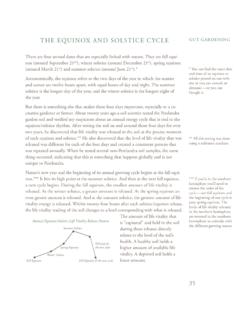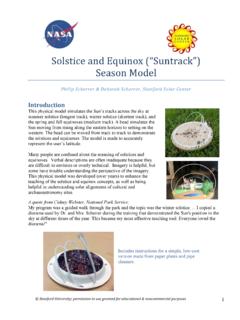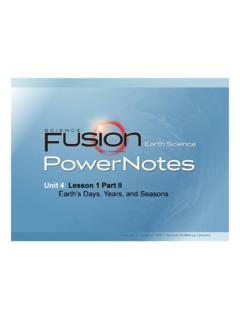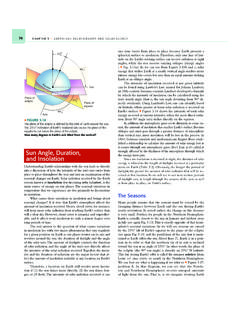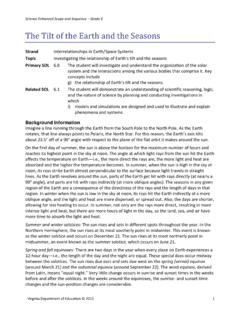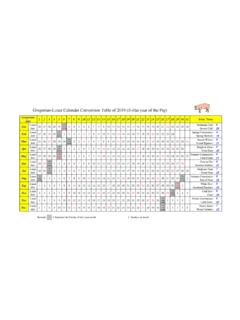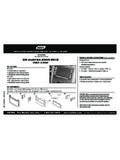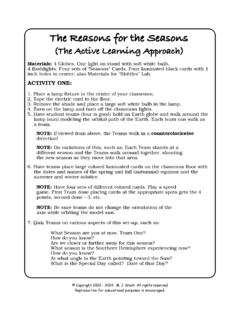Transcription of THE REASON FOR SEASONS - Unite Us
1 Unite US 2010 - 2012 Geophysical Institute, UAF The REASON for SeasonsTHE REASON FOR SEASONS Overview:In this activity, students learn how Earth s tilt and its relation to the sun affect the :The student will: relate Earth s motion around the sun to changes in SEASONS and day and night cycle; examine changes that take place in each season; and list traditional activities that take place in the various Alaska Grade Level Expectations: Science[5-8] The student demonstrates an understanding of the processes of science by asking questions, predicting, observing, describing, measuring, classifying, making generalizations, inferring, and communicating.[8] The student demonstrates an understanding of cycles of influence by energy from the sun and by Earth s position and motion in our solar system by recognizing the relationship between the SEASONS and Earth s tilt relative to the sun and describing the day/night cycle as caused by the rotation of Earth every 24 :axis an imaginary line around which an object rotates; in a rotating sphere, such as Earth an other planets, the two ends of the axis are called polesEarth the third planet from the sun and the fifth largest; the only planet known to support life.
2 The only planet on which water in liquid form exists, covering more than 70 percent of its surfaceequator the imaginary line forming a great circle around Earth s surface halfway between the North and South poles; divides Earth into the Northern Hemisphere and the Southern Hemispherehemisphere one half of a sphere, formed by a plane that passes through the center of the sphere; either the northern or southern half of Earth as divided by the equator, or the eastern or western half as divided by a meridianlatitude distance north or south on Earth s surface, measured in degrees from the equator, which has a latitude of 0 ; used to identify any point on the surface of EarthNorth Pole the northern end of Earth s axis of rotation, a point in the Arctic Oceanorbit the path of a celestial body or an artificial satellite as it revolves around another body; one complete revolution of such a bodyrevolve / revolution the motion of an object around a point, especially around another object or a center of mass; a single complete cycle of such motionrotate / rotation the motion of an object around its own axis; a single complete cycle of such motionseasons one of four natural divisions of the year spring, summer, autumn, and winter in the North or South Temperate Zones.
3 Each season begins as the sun passes through a solstice or an equinoxSouth Pole the southern end of Earth s axis of rotation, a point in Antarcticasun the star that is orbited by all the planets and other bodies of our solar system and that supplies the heat and light that sustain life on Earth; it has a diameter of about 864,000 miles (1,390,000 kilometers) and an average distance from Earth of about 93 million milestilt to cause to have an inclinationWhole Picture:The observation of SEASONS by Alaska Native people is crucial for subsistence hunting, food gathering, celebrations, and other activities important to life in the Arctic. Awareness of seasonal migration patterns and animal behavior, such as mating and birthing, ensures successful fishing and hunting.
4 For example, some animals, such as bears and beavers, hibernate and cannot easily be found throughout the winter season. Salmon return to the rivers from the ocean to spawn at certain times each summer. Integrating Native Knowledge with the science behind the SEASONS brings increased relevance. MS-8 Unite US 2010 - 2012 Geophysical Institute, UAF The REASON for SeasonsTHE REASON FOR SEASONS Earth s four SEASONS (the amount of daylight and the temperature) are caused by its orientation to the sun. The orientation is related to its orbit around the sun, its rotation on its axis, and the degree its axis is rotates counterclockwise on its axis once every 24 hours, creating day and night. Earth orbits the sun in a 365-day cycle.
5 Earth s axis is tilted at an angle of approximately . This angle remains constant throughout its rotation and orbit. Milonkovitch Cycles: changes to axis distance between Earth and the sun varies slightly during its orbit, however this distance has little impact on SEASONS . Instead it is the tilt of Earth on its axis and the orientation of the axis to the sun that creates variations in daylight and temperature, creating seasonal variations. In summer, when the northern hemisphere is tilted toward the sun, it receives a greater amount of solar energy, and therefore experiences warmer temperatures and increased daylight. In winter, when the region is tilted away from the sun, a reduction in solar energy leads to cooler temperatures and reduced daylight.
6 About June 21st, the northern hemisphere is tipped directly toward the sun. Known as summer solstice, this date marks summer s beginning. For most of the hemisphere it is the day of the year with the longest period of September 22nd, Earth has moved around the sun so the poles neither point towards nor away from the sun. This is known as the autumnal equinox, when the entire planet experiences 12 hours of daylight and 12 hours of darkness. This marks the beginning of fall, or winter solstice occurs about December 21st when Earth is oriented so the North Pole is facing away from the sun and the South Pole into the sun. Northern regions experience the shortest period of daylight on this first day of winter.
7 About March 20th, begins the spring equinox. Earth is similarly positioned to that which occurs in September, only on the other side of the sun. Again, the orientation produces 12 hours of daylight and 12 hours of darkness, and signals the beginning of spring, or the vernal :For demonstration: Globe Flashlight Circle stickers (two) Masking tape Sticky notes Refreshments for Elder TEACHER INFORMATION SHEET: Word Table For student activity: Four-inch Styrofoam balls (one per group) Pencils (one per group) Rubber bands (must fit snuggly over Styrofoam ball; one per group) Stickers (two per group) TEACHER INFORMATION SHEET: Word Table STUDENT WORKSHEET: The Four SEASONS STUDENT WORKSHEET: Season Vocabulary: Find Someone Who VISUAL AID: Seasonal Equinox Activity Preparation:1.
8 In advance: Invite an Elder or culture bearer to discuss SEASONS and seasonal changes with your class. Prepare students ahead of time to have appropriate and respectful behavior when an Elder is present. When the Elder or culture bearer arrives, have students greet the guest and escort them to the classroom. Offer NOAA imageMS-9 Unite US 2010 - 2012 Geophysical Institute, UAF The REASON for SeasonsTHE REASON FOR SEASONS refreshments and invite the person to a comfortable spot until they are introduced, but do not keep them waiting long. As Chief Robert Charlie says, Would you keep the governor waiting? 2. Prepare a piece of chart paper or an area of the board for a class vote. Title the chart, The REASON for SEASONS .
9 Divide the area into four sections. Label the sections: How close Earth is to the sun, The moon s influence on tide, Earth s tilt as it orbits the sun, and The sun moves East to West. Cover the chart with a blank piece of chart paper until With masking tape, tape off a large circle representing Earth s orbit on the classroom Prepare Styrofoam balls and Globe:a. Take each ball and insert a pencil through keeping as close to the center as possible. The pencil represents the North and South Poles. Put a rubber band around the middle to represent the On the globe, place one circle sticker on your state and one on the equator. 5. Using the Teacher Information Sheet: Word Table , write the appropriate native language words for the community, along with the English equivalent, on the board for reference.
10 If your community s language is not represented in the table, consider asking your invited guest Elder to teach the words to the Procedure:1. Pass out Student Worksheet, The Four SEASONS , then review the kind of information students will be listening for as they hear from the invited guest. Tell them not to write while they are listening, just to listen for information. Introduce Elder or culture bearer and ask them to share a story or an impression about SEASONS , seasonal changes, what signals a new season, why such knowledge is important, etc. Give students an opportunity to ask questions. Invite the Elder to stay for the remaining class time, if they wish, or leave when they are done sharing. Ask students to complete page one of the STUDENT WORKSHEET: The Four SEASONS .
